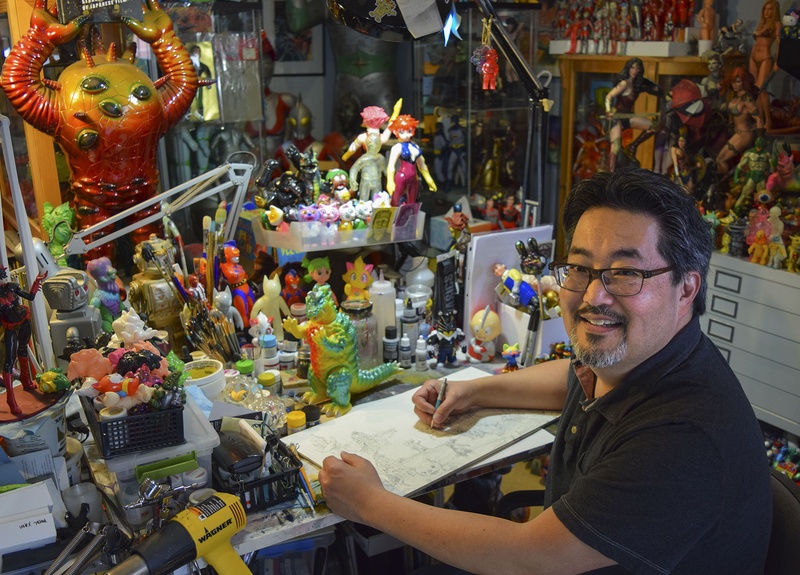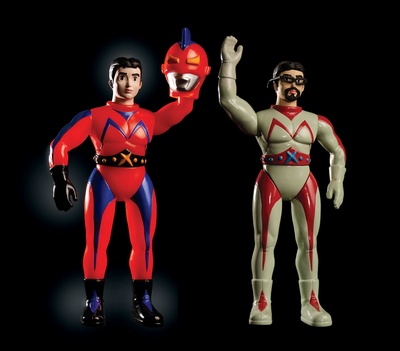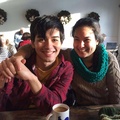Currently featured at the Japanese American National Museum is Mark Nagata’s Kaiju vs Heroes exhibition. Mark Nagata is a third-generation, Japanese American artist who was inspired by the Japanese kaiju toys from his childhood to pursue a career in freelance illustration and eventually start his first toy company called Max Toy Company. His work has left a lasting imprint on the Japanese community, but also his own identity.
As a Sansei, Mark’s upbringing deviated from traditional Japanese culture so he never really considered himself as Japanese. Growing up in the 1970s with his two older sisters, Mark remembers practicing kanji in Japanese school during his elementary years, attending Obon festivals in Japantown with family, and joining his father in the occasional lunch gatherings for his work with other Japanese American families.
Although he was exposed to his Japanese side, he was never taught the cultural and historical context of it. He viewed Japanese school as just something he had to do, Obon festivals as just a spectacle, and the lunch gatherings with his father’s friends as work friends rather than Japanese American friends.
There was one memory Mark remembers feeling confused about with his Japanese identity. During the late 1970s, his family moved to San Francisco where Mark attended grade school. One of his friends in school called him a “Jap” and he did not know how to comprehend the meaning. He thought, “I am an American so that term does not apply to me,” especially since he knew his family had been in the US since the 1920s.
Another memory Mark remembers as a kid was when his parents told him about the Japanese incarceration camp during World War II. Again, he was unable to comprehend the meaning and reasoning for the tragic event because he was very young and did not make much of a connection that he was of Japanese descent.
Part of his perspective and interpretation of his identity comes from the beliefs his parents had instilled in him as a child. He emphasized that his parents would stress that “it was important to just be yourself, to be honest, and to hopefully pursue what interested you in life.” This led him to continue living his life as whom he saw himself to be, an American, not to see racial differences amongst others. Now as an adult, Mark can look back at his past and make better sense of his Japanese identity as well as the historical context and significance of certain events.
It is very common for individuals like Mark to feel confused or disconnected from their Japanese identity because of the sizeable generational gap. That is why some people choose to identify as Nikkei, which does not just include those of Japanese descent but encompasses people of mixed racial descent in a systemic global context. However, in Mark’s case, with the absence of the Japanese American community in his life and overall upbringing he experienced, he says that being Japanese American has never defined him. He lives his life and chooses to not place any label upon himself.
As a result, his individuality and uniqueness translate into his artwork. The Kaiju vs. Heroes exhibit at JANM displays Mark’s work from his co-founded magazine Super 7 to his freelance work with the Goosebumps books to his creation of toys at his own company Max Toy Company, as well as his collection of toys and figures over the years.
When asked to choose a favorite collection featured in the exhibit, he answers that he can’t pick just one because each section contains a certain aspect of who he is. If he had to choose, he would pick the section with his artwork because compared to the toys he’s collected, his artwork is originally handcrafted. In this digital world, Mark feels the authenticity of his collection reflects his identity the most.
As a note to visitors, Mark hopes they feel the same sense of wonderment and joy that kids feel when they play with toys. He also hopes visitors realize that Japan has a long history of amazing characters and understand its worldwide influence.
For example, Mark met many people from around the world who were moved by his show. A family from Mexico grew up watching Ultraman in the 1970s, a visitor from Italy recalled their childhood show Space Giants, and others from Hawaii loved Kikaida. All the visitors enjoyed seeing the display of their favorite characters at his show. It brings together a collective and connects one another on a global scale.
Mark also hopes visitors understand that part of what has propelled him onto this path is a result of his parent’s incarceration. He hopes people will take the time to see the incarceration exhibits upstairs at JANM and to learn more (if they are not already aware of it). Lastly, seeing kids react with amazement towards the toys and video game is an accomplishment for Mark. He hopes to influence and inspire one of them to grow up to become an artist, video game maker, or movie maker just as he had been forty-five years ago.
* * * * *
Kaiju vs Heroes: Mark Nagata’s Journey through the World of Japanese Toys
September 15, 2018 — July 7, 2019
Japanese American National Museum
Los Angeles, California
In California in the 1970s, Mark Nagata was living an all-American childhood when an aunt and uncle serving on a US military base in Japan sent him a box filled with some of that country’s most popular toys. They were kaiju and heroes, and these gifts inspired him to zealously collect vintage Japanese vinyl toys over the course of his entire life.
Kaiju vs Heroes: Mark Nagata’s Journey through the World of Japanese Toys showcases hundreds of dazzling vintage and contemporary Japanese vinyl toys, providing a feast for the eyes and the imagination.
For more information about the exhibition >>
© 2018 Kate Iio









